The Széchenyi fürdő (Széchenyi Bath) is the largest of the many medicinal bath complexes in Budapest. It is even the largest such complex in Europe. Its indoor pools are housed in a palatial Neo-Baroque building.
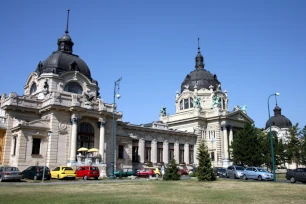

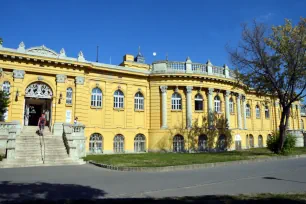
The pools of the Széchenyi Baths are naturally heated thanks to hot springs that were discovered deep underground.
Hot Springs
The origin of the Széchenyi Baths can be traced back to 1868 when Vilmos Zsigmondy, a mining engineer, started drilling in the city park to find a thermal spring. It wasn’t his first such endeavor; just one year before, he had managed to find a spring 120 meters under Margaret Island. This one turned out to be much more difficult: after fruitlessly drilling for ten years, he finally succeeded in 1878, when an artesian hot spring was found at a depth of 970 meters.
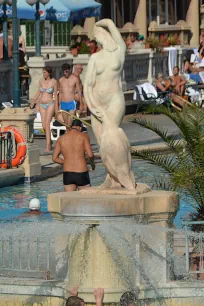
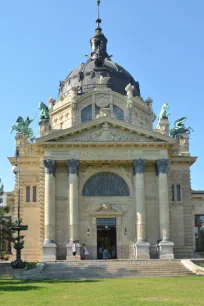
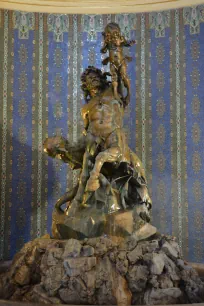

The Bathhouse
Soon after the discovery the city council decided to open a bathhouse at the site which opened in 1881. This building, which was known as the Artesian Bath, was soon deemed inadequate and plans were made for a large spa complex. In 1903 architect Győző Czigler drew up plans for a new building. When construction finally started in 1909 Czigler had passed away, and supervision of the construction was delegated to Ede Dvorák and Kálmán Gerster, who followed Czigler’s monumental design.
The new bath complex opened in 1913 as the Széchenyi gyógyfürdő (Széchenyi spa), in honor of count István Széchenyi, a nineteenth-century statesman. The complex was further expanded in 1927, but it was soon discovered that one thermal spring was insufficient to provide enough water for all the new pools. Therefore, drilling was resumed, which resulted in the discovery of another hot spring in 1938, this time at a depth of 1,200 meters.
In 1999 the pools were renovated and new equipment such as neck showers and a whirlpool were installed to keep the spa up with the times.
The Building
The main building of the Széchenyi Baths, the Czigler-wing, is truly impressive. The front facade, dominated by three large domed pavilions, is more reminiscent of a palace than a bathhouse. The roof of the central hall is decorated with bronze statues of galloping horses, and the entrances are flanked by massive Corinthian columns.
The 1927 Francsek-wing on the north side, opposite the Czigler-wing, curves around the pools. Its design by Imre Francsek, in Neo-Renaissance style, is equally grand, with colonnaded arches and loggias. The roof balustrades are decorated with statues and ornaments. The outdoor pool area is also embellished with statues, balustrades and urns and there are even fountains near the pools.
The interior is equally impressive, in particular the main entrance hall of the Czigler-wing, which has a dome decorated with a mosaic that shows the sun god Helios driving a four-horse chariot. Inside the hall stands a fountain with a fascinating statue of a centaur. The fountain was created by József Róna, a Hungarian sculptor best known for his statue of Prince Eugene at the Buda Castle.
The Baths
There are in total fifteen indoor and three outdoor pools. There are a further ten saunas and steam chambers inside the complex. Thanks to the two hot springs, which provide water with a temperature of 74 and 77 degrees Celsius, the outdoor pools can stay open year-round. The three outdoor pools all have different temperatures: the middle one is a swimming pool with a temperature of around 27 degrees. The adventure pool, a shallow pool with massaging jets, has a temperature of around 33 degrees. The third and hottest pool contains mineral water and has a temperature of about 38 degrees. In this pool, you can often see people play chess while submerged up to their chest. Even former world champion Bobby Fisher played here.
The indoor pools are often used for medicinal purposes. The water from the springs contains plenty of minerals and is particularly recommended for people with joint or muscle pains.

